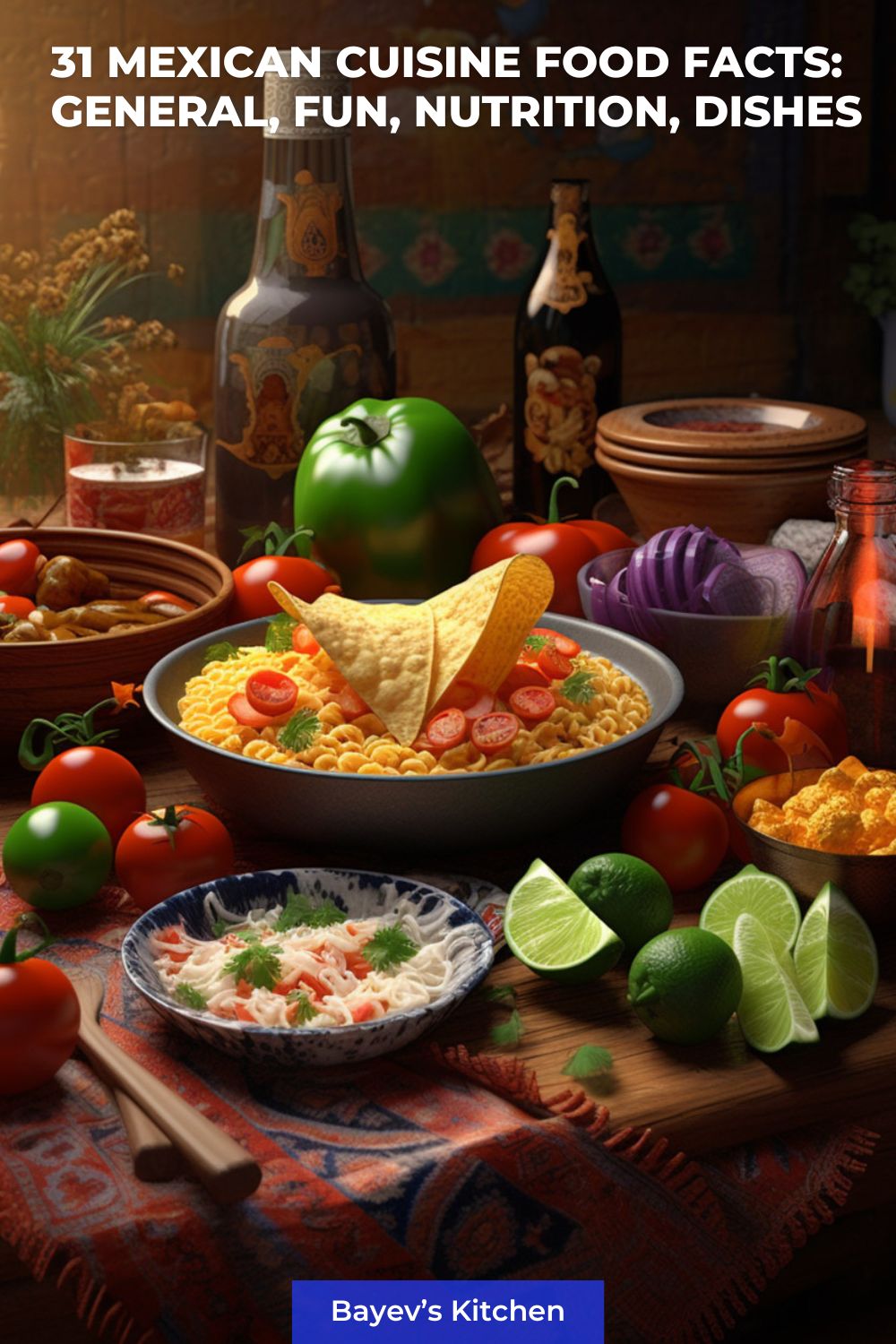Mexican cuisine is a rich amalgamation of diverse influences and a testament to the country’s history. The following article presents a series of intriguing facts about Mexican food, broken down into several categories for your perusal.
The Pre-Columbian Era: Culinary Practices of Ancient Mexican Civilizations
The history of food and culinary practices in ancient Mexico is as rich and varied as its landscapes. Let’s explore the diets and culinary traditions of three predominant civilizations that flourished before the arrival of the Spanish: the Aztecs, Maya, and Olmecs.
The Aztecs
Diet:
- Staple Foods: Maize (corn) was central to the Aztec diet and was used in various dishes. This includes tortillas, tamales, and atoles (a type of gruel).
- Protein Sources: Beans, amaranth, insects (like grasshoppers), wild game (like turkey and deer), and fish from nearby lakes.
- Vegetables & Fruits: Tomatoes, avocados, guavas, and chili peppers. The chili pepper was not just a food but also a major flavoring for dishes.
Culinary Practices:
- Chocolate, derived from cacao, was a luxurious drink reserved for nobility. Unlike the sweet beverage of today, it was bitter and often mixed with spices.
- They also made a fermented drink from the sap of the maguey plant called pulque.
The Maya
Diet:
- Staple Foods: Like the Aztecs, maize was vital for the Maya. They too made tortillas and tamales.
- Protein Sources: The Maya primarily consumed fish, turkey, and venison. Beans provided an essential source of protein.
- Vegetables & Fruits: Squashes, beans, chili peppers, avocados, and cacao.
Culinary Practices:
- The Maya practiced nixtamalization – treating corn with lime (calcium hydroxide) to increase its nutritional value.
- They drank xocolatl, a spiced chocolate beverage, which was a precursor to the modern hot chocolate.
The Olmecs
Diet:
- Staple Foods: The Olmecs cultivated maize, but also beans, squash, and manioc (cassava).
- Protein Sources: They fished along the Gulf Coast and hunted deer, peccary, and rabbits in the forests.
- Vegetables & Fruits: They consumed avocados and enjoyed the juice of the prickly pear cactus.
Culinary Practices:
- The Olmecs are believed to be the first Mesoamerican civilization to have cultivated cacao, leading to the rich tradition of chocolate in the region.
- Much of the Olmec’s culinary techniques and ingredients laid the foundation for the future civilizations of the Maya and Aztecs.
In conclusion, while each of these civilizations had its unique twists and variations, the foundational ingredients of maize, beans, chili peppers, and cacao thread through all their diets, setting the stage for the rich and diverse world of Mexican cuisine that we know and love today.
Changes in Mexican Cuisine Post-Spanish Colonization
Mexican cuisine has a rich and diverse history, with roots that stretch back thousands of years to the indigenous cultures that inhabited the region. However, the arrival of the Spanish in the 16th century heralded a transformative period for Mexican food, introducing new ingredients, techniques, and culinary traditions. Here’s an exploration of how Spanish colonization impacted and enriched the flavors and traditions of Mexican gastronomy.
Introduction of New Ingredients
One of the most profound effects of Spanish colonization was the influx of new ingredients that were previously unknown in Mexico:
- Livestock: Before the Spanish arrived, the indigenous peoples of Mexico did not have animals like cows, pigs, and chickens. With the introduction of these animals, dishes like tacos al pastor (pork), beef stews, and chicken in mole sauce became possible.
- Dairy: Dairy products such as cheese, milk, and butter were also introduced by the Spanish. This led to the creation of quesadillas, enchiladas with cheese, and many desserts that feature dairy prominently.
- Rice & Wheat: While corn was (and remains) a staple of Mexican cooking, the introduction of rice and wheat brought about dishes like arroz con leche (rice pudding) and wheat-based tortillas.
- Spices: The Spanish brought with them spices from the Old World, such as cinnamon and cloves, which were incorporated into many Mexican dishes, adding depth and complexity.
Culinary Fusion and Evolution
The amalgamation of indigenous Mexican and Spanish culinary traditions resulted in entirely new dishes:
- Mole: While the indigenous peoples of Mexico already had versions of mole, the addition of Spanish spices and chocolate (which the Aztecs consumed as a bitter beverage) transformed it into the rich, multifaceted sauce we know today.
- Chiles Rellenos: This dish, which consists of stuffed, breaded, and fried chilies, combines the indigenous chili pepper with Old World cheese and meat fillings.
Impact on Cooking Techniques
Spanish culinary techniques also influenced Mexican cooking:
- Baking: With the introduction of wheat, the Spanish brought with them European baking techniques. This led to the birth of Mexican breads like bolillos and pastries like churros.
- Stewing: Spanish-style slow-cooked stews combined with indigenous ingredients resulted in dishes like pozole and menudo.
The Spanish colonization of Mexico, while undeniably fraught with conflict and oppression, had a lasting impact on Mexican cuisine. The fusion of Old World and New World ingredients and techniques created a culinary tradition that is both rich in history and flavor. Today, the dishes that emerged from this melding of cultures are celebrated not just in Mexico but around the world, a testament to their enduring appeal and the resilience of Mexican culinary heritage.
10 Staples of Mexican Cuisine
Mexican cuisine is an intriguing blend of flavors, traditions, and history. At its heart, there are several ingredients and techniques that define its essence. Here’s an overview of the staples of Mexican food:
1. Corn (Maize)
- A primary ingredient that has been part of Mexican cuisine since ancient times.
- It’s used in many forms: tortillas, tamales, and even beverages like atole.
- The process of nixtamalization, where corn is soaked in an alkaline solution, enhances its nutritional value and is vital for making masa, the dough used in tamales and tortillas.
2. Beans
- A crucial source of protein and fiber.
- Varieties include black beans, pinto beans, and red beans.
- Often served whole, mashed (as in refried beans), or in soups and stews.
3. Chili Peppers
- Ranging from mild to fiery hot, chilies are an integral part of Mexican dishes.
- Examples include jalapeño, serrano, poblano, and the hotter habanero.
- Roasting chili peppers is a popular method to enhance their flavor.
4. Rice
- Introduced by the Spanish, rice became a staple side dish, often flavored with tomatoes and vegetables.
5. Tomatoes
- Used fresh in salsas, cooked in stews, or even dried for certain sauces.
6. Meats
- Pork, chicken, beef, and lamb are commonly used.
- Methods of preparation vary, from grilling to slow-cooking, as in barbacoa.
7. Cheese
- Varieties such as queso fresco, cotija, and Oaxaca cheese are used to garnish or fill dishes.
8. Herbs and Spices
- Cilantro, oregano, cumin, and cinnamon are among the commonly used seasonings.
- Chocolate, particularly in the preparation of certain mole sauces, showcases the depth of Mexican culinary traditions.
9. Avocados
- Used in guacamole, salads, or even just sliced on top of many dishes for added creaminess.
10. Cactus (Nopal)
- Edible cactus pads, or nopales, are a unique ingredient in salads and other dishes.
Mexican cuisine’s beauty lies in its varied regional interpretations and the deep cultural significance behind each dish. These staples, intertwined with traditional techniques and flavors, result in a cuisine that is rich, diverse, and utterly delightful.
General Facts
Fact 1: A Blend of Cultures
Mexican cuisine is a delightful blend of Indigenous, Spanish, and other global influences. The indigenous people of Mexico primarily used corn, beans, and chili peppers in their meals, a tradition that has been carried forward to today.
With the arrival of the Spanish, new ingredients like rice, wheat, and meats were introduced, adding complexity to the cuisine.
Fact 2: UNESCO Recognition
In 2010, Mexican cuisine was recognized by UNESCO as an Intangible Cultural Heritage of Humanity. This accolade reflects the significant role that traditional Mexican food plays in the country’s cultural identity.
Fact 3: Regional Diversity
Mexico’s cuisine varies significantly by region. For example, the north is known for its meat dishes, while the south is famous for its spicy vegetables and chicken.
Coastal areas primarily focus on seafood, while Oaxaca, often referred to as the “land of seven moles,” is renowned for its variety of mole sauces.
Fact 4: Staple Ingredients
Corn, beans, and chili peppers are considered staple ingredients in Mexican cuisine. They are used in a multitude of dishes, from tamales and tortillas to salsas and soups.
Fact 5: The Importance of Maize
Maize, or corn, is a central ingredient in Mexican cuisine. It’s used to make tortillas, tamales, and a variety of other dishes. Its importance can be traced back to the Mayan civilization, which regarded maize as sacred. One is great examples is mexican corn salad.
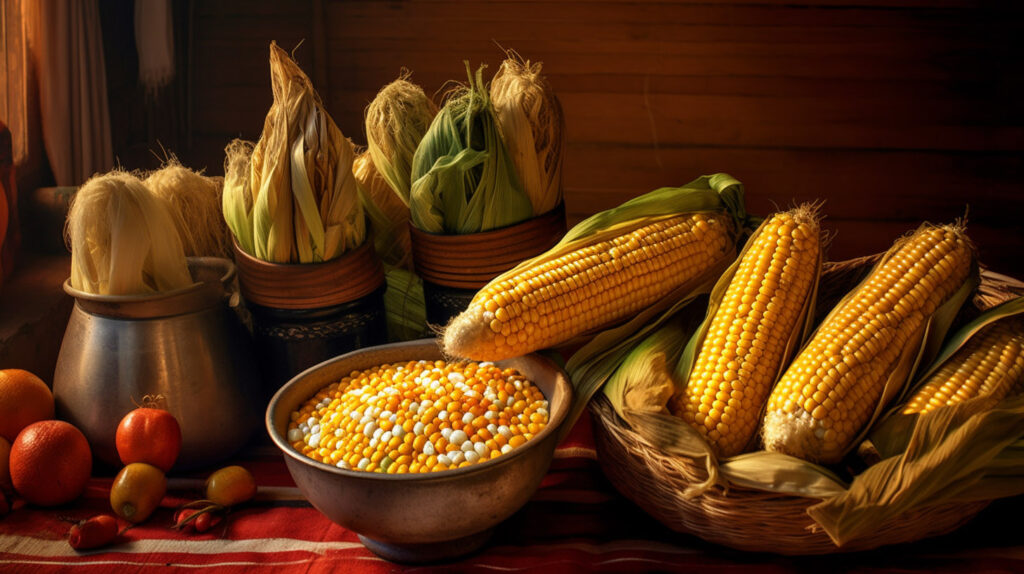
Fun Facts
Fact 6: Chocolate’s Mexican Roots
Chocolate originated in Mexico, not Switzerland or Belgium. The ancient Mayans were the first to cultivate cacao beans and they used them to make a bitter beverage.
Fact 7: Tequila’s Protected Status
Tequila is a Mexican-origin drink that has a Denomination of Origin, meaning it can only be produced in certain regions. Specifically, it must be made in the Mexican state of Jalisco or in certain municipalities of Guanajuato, Michoacán, Nayarit, and Tamaulipas.
Fact 8: The World’s Largest Tamale
The largest tamale ever made was in Mexico. Created in 2010 in the city of Urupan, Michoacan, the tamale measured 11.99 meters and weighed 1,086 kilograms.
Fact 9: The Hottest Chili in the World
The Carolina Reaper may hold the title for the hottest pepper in the world, but did you know that the title used to belong to the Mexican-grown Ghost Pepper (Bhut Jolokia)?
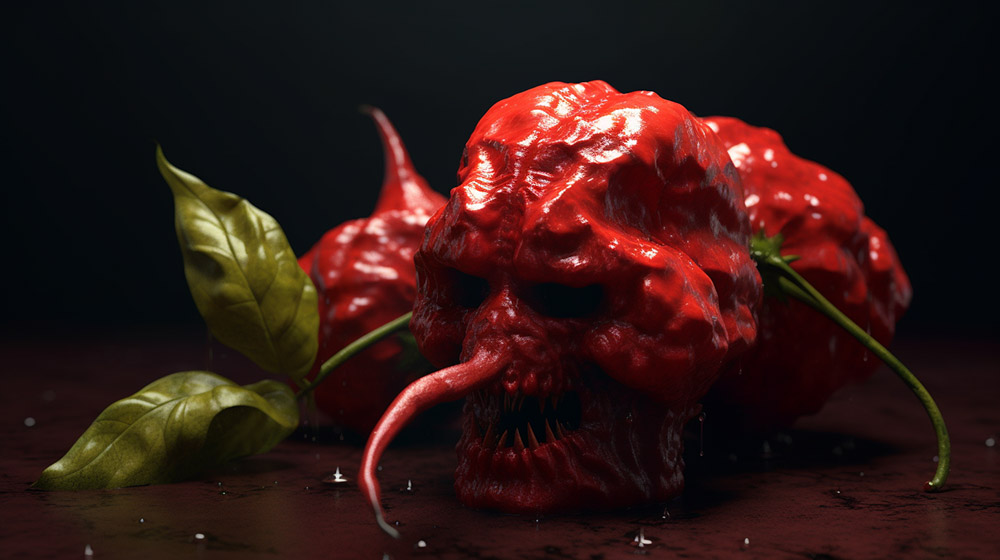
Fact 10: Burritos Aren’t Universally Mexican
Despite their global popularity, burritos are not widely eaten in Mexico. They are more typical of the Tex-Mex food found in the United States.
Nutrition Facts
Fact 11: High in Fiber
Traditional Mexican food is often high in fiber due to the heavy use of legumes like beans and high-fiber vegetables.
Fact 12: Rich in Vitamins and Minerals
Mexican cuisine is typically rich in vitamins and minerals. Ingredients like tomatoes, peppers, and avocados provide significant amounts of Vitamin C, A, and potassium.
Fact 13: Balanced Proteins
Mexican food often features a healthy balance of proteins. Beans and corn, which are staples in the diet, together form a complete protein.
Fact 14: Potential for Lower Calorie
While many popularized versions of Mexican food are high in calories, traditional Mexican dishes can often be made as lower-calorie options. By focusing on fresh vegetables, lean proteins, and whole grains, many Mexican dishes can be part of a balanced diet.
Fact 15: Probiotic Benefits
Fermented foods like pickled vegetables and certain types of salsas are often found in Mexican cuisine. These foods contain beneficial bacteria that can aid in digestion.
Influence on Global Cuisine
Fact 16: Tex-Mex
Tex-Mex is a fusion of Mexican and American cuisines, originating from the border states of Texas and Mexico. Notable dishes include nachos, hardshell tacos, and chili con carne.
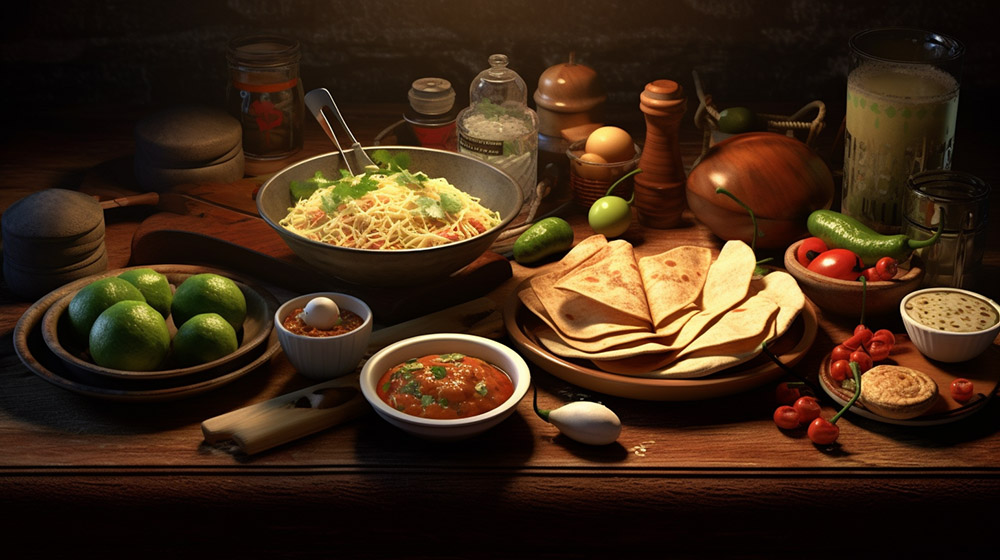
Fact 17: Mexican Street Food
Mexican street food, or antojitos, is popular worldwide. Tacos, quesadillas, and churros have found their way into global street food culture.
Fact 18: Influence in the Philippines
Mexico’s culinary influence can be seen in Filipino cuisine due to the Manila-Acapulco galleon trade (1565-1815). Dishes like adobo and lechon show evidence of this historical link.
Fact 19: Nachos Around the World
Nachos, despite being a relatively modern and non-traditional dish, have gained international popularity. They are enjoyed with a variety of toppings across the globe.
Fact 20: Tequila’s Global Popularity
Tequila, a Mexican-origin spirit, is enjoyed around the world, often in cocktails like the Margarita. It’s a testament to the global influence of Mexican beverages.
Traditional Dishes
Fact 21: Tacos Predate the Europeans
The origins of the taco, a staple of Mexican cuisine, are believed to predate the arrival of Europeans in Mexico. Anthropological evidence suggests that the indigenous people living in the lake region of the Valley of Mexico traditionally ate tacos filled with small fish.
Fact 22: Mole’s Many Varieties
Mole, a traditional Mexican sauce, comes in various colors and flavors. These can include mole negro, mole rojo, and mole verde, each offering a unique blend of spices, chilies, and sometimes even chocolate.
Fact 23: The Birth of Chiles en Nogada
The patriotic dish, Chiles en Nogada, was reportedly invented by nuns in Puebla in the 19th century. The dish’s colors—green chile, white walnut sauce, and red pomegranate seeds—mirror the Mexican flag.
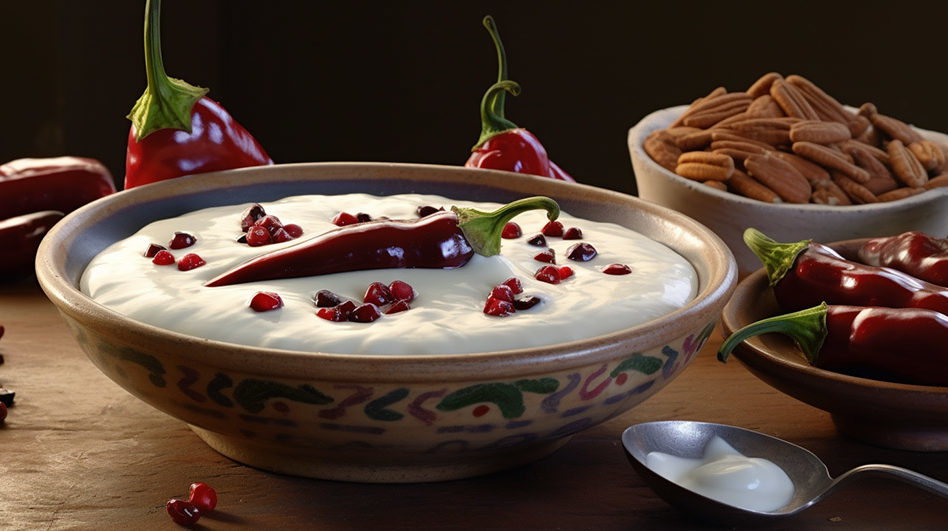
Fact 24: The Importance of Pozole
Pozole, a traditional soup made with hominy (dried corn kernels), meat, and garnished with shredded lettuce, chili pepper, radish, onion, lime, and oregano, is often served on special occasions, particularly Mexico’s Independence Day.
Fact 25: Tamales: A Celebration Food
Tamales, made of masa (a dough from corn) filled with meats, cheeses, fruits, vegetables, or chilies, wrapped in a corn husk and steamed, are often made for celebrations. The process is labor-intensive, making them a special treat.
Culinary Techniques
Fact 26: Nixtamalization
Nixtamalization is a culinary technique where corn is soaked and cooked in an alkaline solution, usually limewater, then hulled. This process, used in Mexican cuisine, significantly enriches the nutritional value of maize.
Fact 27: Stone Grinding Maize
Traditional Mexican cuisine often involves grinding maize on a stone slab with a cylindrical stone, or metate. This process helps to produce a finer dough for tortillas and tamales.
Fact 28: Pit Cooking
Barbacoa, a cooking method that involves slow-cooking meat (usually lamb or beef) in a pit, is a traditional technique still used in many parts of Mexico.
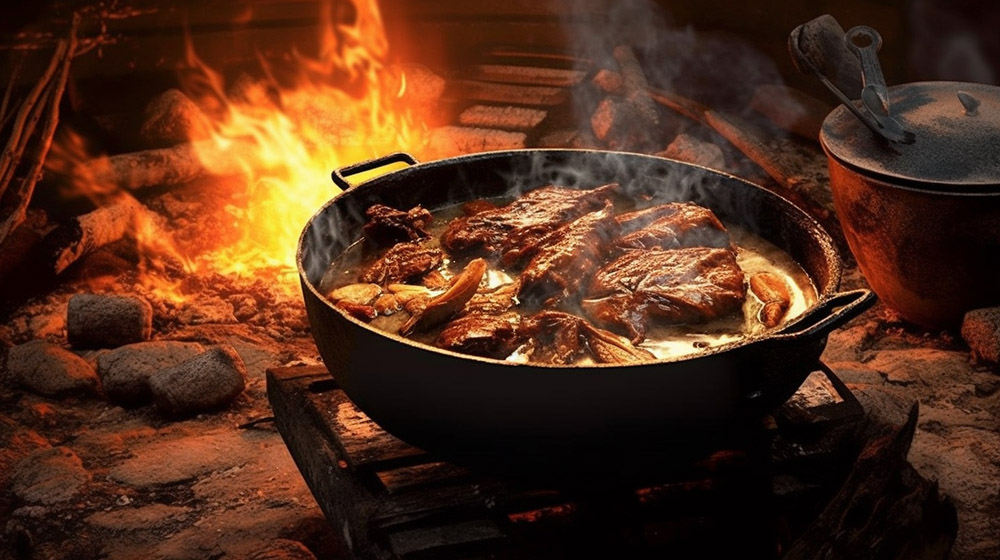
Fact 29: The Art of Tamale Wrapping
Wrapping tamales is an art form in itself. Whether it’s in corn husks or banana leaves, the wrapping process is usually a family affair with many hands helping out.
Fact 30: Clay Pot Cooking
Mexican cuisine often involves cooking in clay pots, which are believed to impart a unique flavor to the food. This technique is especially used in making traditional dishes like mole and stews.
Fact 31: Roasting Chili Peppers
Roasting chilli peppers is a popular way to prepare chili peppers in Mexican cuisine. This process enhances the flavor of the peppers and makes the skin easier to remove.
